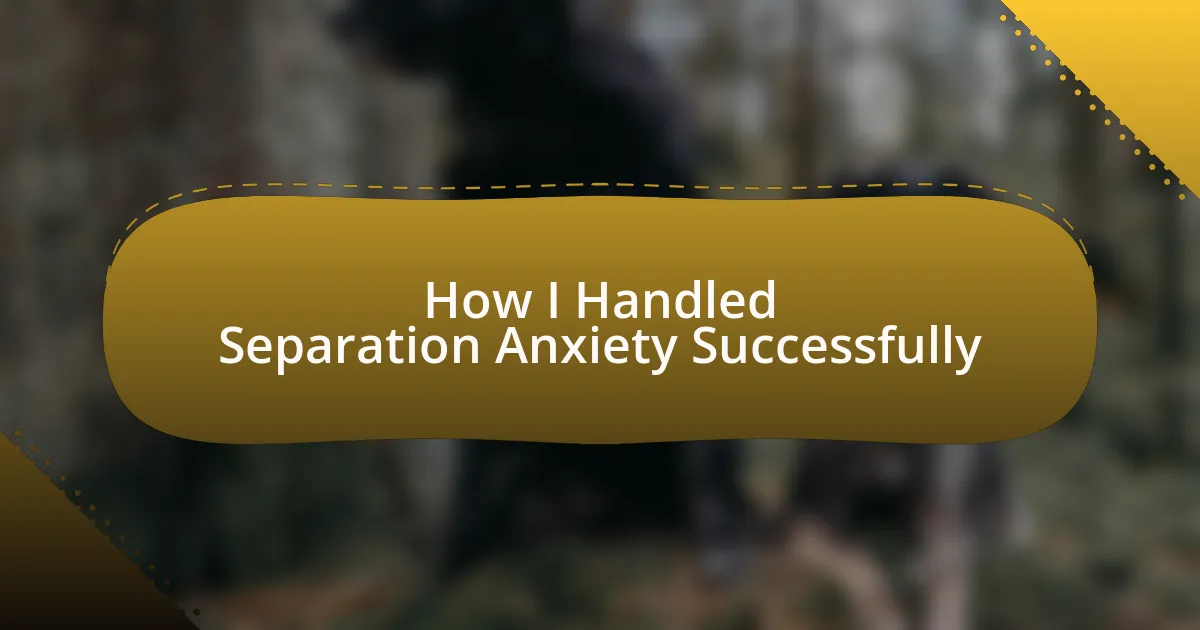Key takeaways:
- Separation anxiety in dogs is a significant emotional struggle that manifests through behaviors like pacing, whining, and destructive actions.
- Implementing coping strategies, such as consistent departure routines and gradual absences, can improve a dog’s emotional well-being.
- Creating a calm environment with tools like pheromone diffusers can help ease anxiety in pets.
- Patience, consistency, and understanding of a dog’s anxiety are essential in fostering their sense of security during separations.
Author: Clara Ashford
Bio: Clara Ashford is an acclaimed author known for her evocative storytelling and richly drawn characters. With a background in psychology and literature, she weaves complex narratives that explore the human experience and emotional depth. Her debut novel, Whispers in the Wind, captivated readers and critics alike, earning her a place among contemporary voices in fiction. Clara resides in the Pacific Northwest, where the lush landscapes inspire her writing. When she’s not crafting her next tale, she enjoys hiking, painting, and engaging with her vibrant community of fellow writers.
Understanding separation anxiety in dogs
As I began to understand the intricacies of separation anxiety in dogs, I realized it’s more than just a minor inconvenience. It’s a genuine emotional struggle that many dogs face when their humans leave, often leading to stress and distressed behaviors. Have you ever noticed your dog pacing or whining right before you step out the door?
One evening, I found my pup, Bella, frantically digging at the couch when I simply grabbed my keys. The panic in her eyes made me consider how deeply our bond affected her sense of security. This experience underscored how crucial it is to recognize those signs of anxiety early—like excessive barking or destructive chewing—because they are her way of expressing fear.
Separation anxiety can stem from various factors, such as a traumatic experience or a lack of routine. In my journey, I’ve discovered that understanding the root cause is vital in addressing it effectively. It’s a journey, but as I navigated through Bella’s anxiety, I learned that patience and consistent training are key. Isn’t it amazing how our understanding can transform our approach to helping our furry friends?
Implementing coping strategies for dogs
Implementing coping strategies for dogs can truly make a difference in their emotional well-being. One approach that worked wonders for Bella was establishing a consistent departure routine. I started leaving her with a favorite toy stuffed with treats whenever I stepped out. The first time I did this, I watched her tail wag with excitement, almost as if she understood that I was creating a positive association with my departure.
Another strategy I found effective was gradually extending the time I spent away. I began with just a few minutes and slowly increased that duration. During one of these short outings, I returned to find her waiting patiently by the door, tail wagging. This made me realize that building her confidence was just as important as my calming presence.
I also sought to create a calmer environment using natural calming aids, such as pheromone diffusers. I remember how, one particularly anxious day, I turned on the diffuser and noticed Bella’s demeanor shift to a more relaxed state within minutes. It was a small change, but it felt monumental in helping her cope. Do you have a go-to calming technique for your own pup?
Personal experiences with separation anxiety
In my journey with separation anxiety, I vividly recall the first time I left my dog, Max, alone. I had this pit in my stomach, worried about how he would react. To my surprise, he greeted the sound of the door closing with an exaggerated sigh, which left me wondering if he truly understood my need to leave or if he was just resigned to it.
One day, after a particularly long absence, I returned home to a welcome that felt both joyful and bittersweet. Max was ecstatic, but I also noticed the little signs of anxiety in his overly frantic demeanor. It struck me then that his excitement was mixed with fear of me leaving again. This realization prompted me to consider how my actions could either ease his worries or exacerbate them.
Reflecting on those moments, it became clear that patience and consistency were key. Each time I returned, I made it a point to remain calm and unhurried, hoping to reinforce a sense of security for him. How could we foster a sense of safety amidst the uncertainties of separation? I believe that through gentle repetition and care, we can help our dogs find comfort in our absence.

Leave a Reply